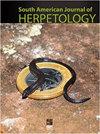Antioxidant Enzymes in Destructible and Non-Destructible Tissues in American Alligators (Alligator mississippiensis)
IF 0.7
4区 生物学
Q4 ZOOLOGY
引用次数: 0
Abstract
Abstract. Anthropogenic-derived stressors represent an ever-increasing risk to organisms worldwide. To understand the effects of stressors on organisms, many studies measure an organism's oxidative status. American alligators (Alligator mississippiensis) are long-lived, top trophic carnivores that have been suggested to serve as an indicator of environmental quality. Raised tail scutes on crocodilians are often marked to enable easy subsequent identifications. Recent studies have illustrated scutes can also serve as indicators of stress or toxicant exposure. In this study, we investigated another role of scutes: as potential non-destructive (i.e., not requiring euthanasia to obtain) indicators of oxidative status. Three antioxidant enzymes, superoxide-dismutase (SOD)-1, SOD2, and glutathione peroxidase (GPX), were measured in non-destructible (i.e., tail scutes) and destructible tissues using Western blot. Enzyme levels were then compared with body condition and health using principal component analysis (PCA). Linear mixed models revealed that tissue had a significant effect on relative enzyme level (all P < 0.05). PCAs revealed significant groupings (eigenvalues > 1) of both tail scutes and destructible tissues. Levels of GPX1 in tail scutes were positively related with body condition and organ mass. Our results suggest antioxidant enzyme levels in alligator tail scutes may serve as important, non-destructive indicators of internal organ and whole-body oxidative status. In addition, tail scute antioxidants may also provide insight into alligator body condition and health. Future studies involving captive or wild individuals should incorporate measuring tail scute antioxidant enzyme levels, along with more traditional stress parameters, to better understand how stressors affect crocodilians.美洲鳄(短吻鳄)可破坏和不可破坏组织中的抗氧化酶
摘要人为来源的压力源对世界范围内的生物构成了日益增加的风险。为了了解压力源对生物体的影响,许多研究测量了生物体的氧化状态。美洲短吻鳄(密西西比短吻鳄)是长寿的顶级营养食肉动物,被认为是环境质量的指标。鳄鱼尾部凸起的鳞片通常有标记,以便于随后的识别。最近的研究表明,鳞甲也可以作为压力或有毒物质暴露的指标。在这项研究中,我们研究了鳞片的另一个作用:作为潜在的非破坏性(即,不需要安乐死获得)氧化状态的指标。采用Western blot法检测非破坏组织(即尾鳞)和可破坏组织中超氧化物歧化酶(SOD)-1、SOD - 2和谷胱甘肽过氧化物酶(GPX) 3种抗氧化酶的含量。然后使用主成分分析(PCA)将酶水平与身体状况和健康状况进行比较。线性混合模型显示,组织对相对酶水平有显著影响(均P < 0.05)。pca显示了尾部鳞片和可破坏组织的显著分组(特征值> 1)。尾鳞GPX1表达水平与机体状况和器官质量呈正相关。我们的研究结果表明,鳄尾鳞片中的抗氧化酶水平可能是内脏和全身氧化状态的重要非破坏性指标。此外,尾鳍的抗氧化剂也可以为了解鳄鱼的身体状况和健康状况提供线索。未来涉及圈养或野生个体的研究应该包括测量尾鳞抗氧化酶水平,以及更传统的压力参数,以更好地了解压力源如何影响鳄鱼。
本文章由计算机程序翻译,如有差异,请以英文原文为准。
求助全文
约1分钟内获得全文
求助全文
来源期刊
CiteScore
1.50
自引率
0.00%
发文量
10
期刊介绍:
The South American Journal of Herpetology (SAJH) is an international journal published by the Brazilian Society of Herpetology that aims to provide an effective medium of communication for the international herpetological community. SAJH publishes peer-reviewed original contributions on all subjects related to the biology of amphibians and reptiles, including descriptive, comparative, inferential, and experimental studies and taxa from anywhere in the world, as well as theoretical studies that explore principles and methods.

 求助内容:
求助内容: 应助结果提醒方式:
应助结果提醒方式:


